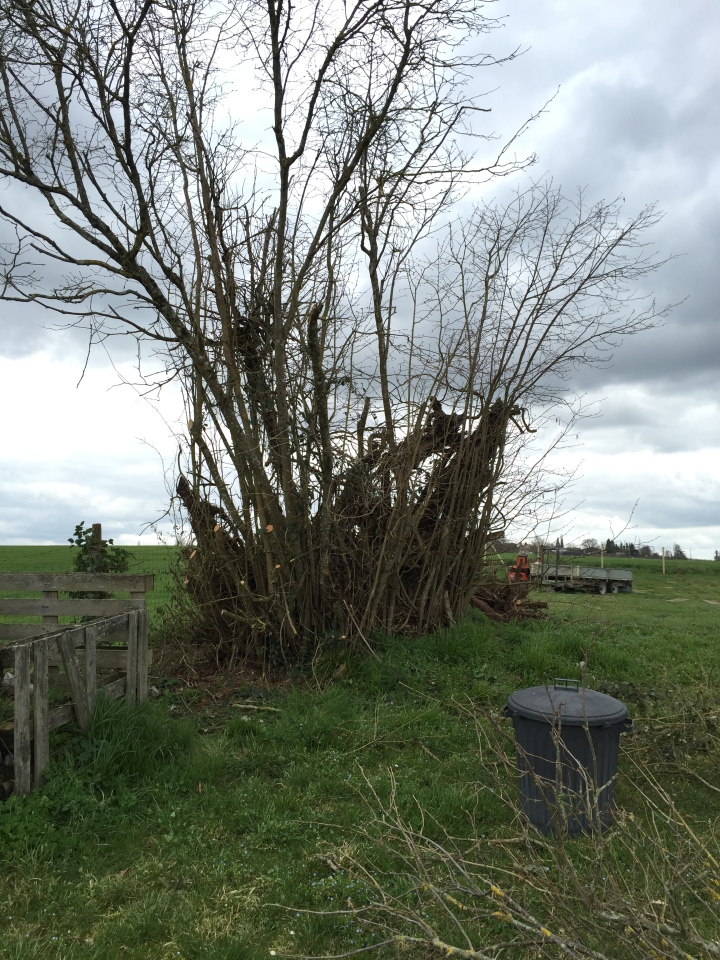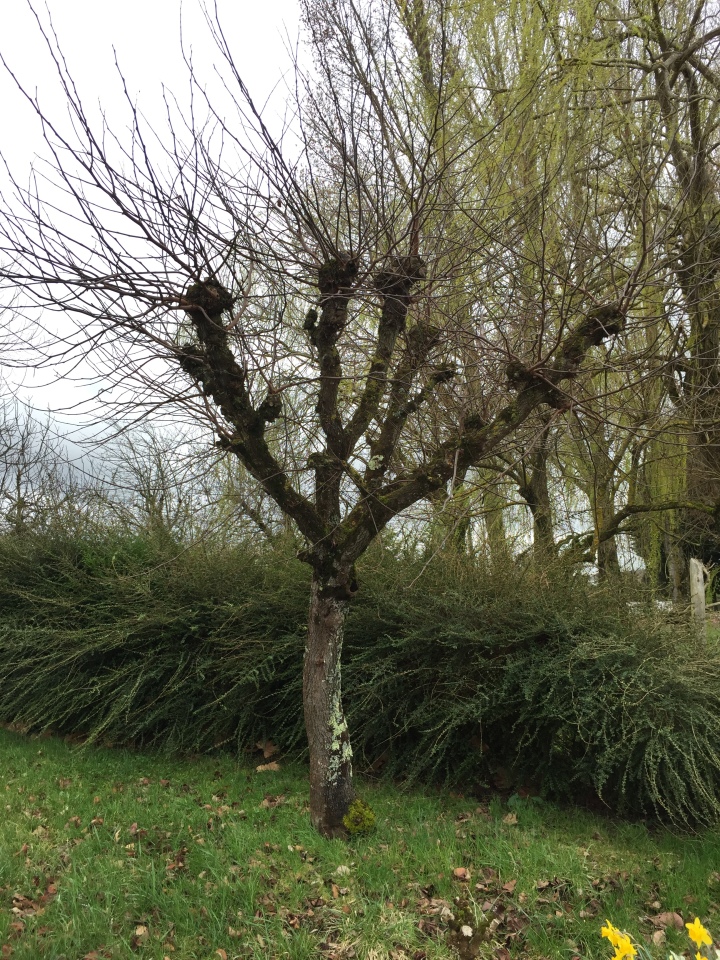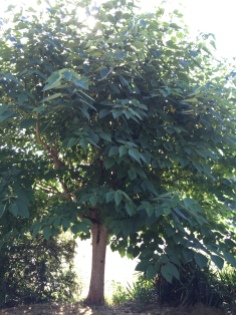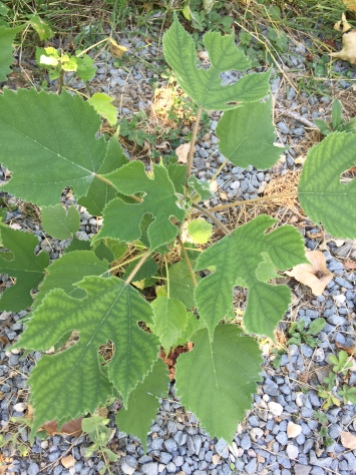Fruit and nuts
Eating warm, ripe fruit, in the sunshine, straight from one’s own trees is an intense joy that we discovered last summer. We probably won’t be able to grow much, if any, vegetables and salad as we are not at the house full-time, but we can enjoy fruit and nuts we’ve grown ourselves, and we’ve inherited a few useful trees.
 We’ve inherited a lovely walnut tree, in the top left-hand, north-west corner of the garden. It has a pleasing shape and creates welcome, dense, cool shade in summer. The grass under the tree grows better than anywhere else in the garden so this is a very good place to sit. I hope to install a tree seat, one that circles the trunk. Internet research has uncovered a wide range of budgets and styles on offer, from quite basic circles (most likely for us!) to sinuous, highly decorative works of art. The partner of the lovely lady who helps us in the house is a carpenter; perhaps he might be able to help? The tree produced many walnuts last year, but we left them to the birds and local wildlife not having the time or resources to collect and store them. Next year …
We’ve inherited a lovely walnut tree, in the top left-hand, north-west corner of the garden. It has a pleasing shape and creates welcome, dense, cool shade in summer. The grass under the tree grows better than anywhere else in the garden so this is a very good place to sit. I hope to install a tree seat, one that circles the trunk. Internet research has uncovered a wide range of budgets and styles on offer, from quite basic circles (most likely for us!) to sinuous, highly decorative works of art. The partner of the lovely lady who helps us in the house is a carpenter; perhaps he might be able to help? The tree produced many walnuts last year, but we left them to the birds and local wildlife not having the time or resources to collect and store them. Next year …

A hazelnut close to the top boundary with the farmer’s field had long since grown into an unmanageable thicket complicated by various long-decayed structures. It has recently been bulldozed by Digger Dave and fuelled a splendid bonfire; I have no doubt we will replace it in due course, whether as part of hedging or a nuttery I don’t yet know.
A few small fruit trees, including apples, have been planted closer to the house in recent years and I’ve concentrated on some serious pruning this past winter to try and encourage them to increase their fruiting on better-shaped trees. I am not sure whether they have a long-term future in the master plan, but they are good for now.
Two very sweet green figs fruited prolifically last summer/autumn, as did a black fig above the swimming pool. All are badly in need of thinning out and pruning.
Other fruit trees include cherries, black and white, mostly eaten by birds last year, some small, bitter peaches, a caci which didn’t fruit at all last year and which probably doesn’t have much future given that it is directly on the boundary, a medlar, a quince, and a mirabelle which seems to have suffered from last summer’s drought. My one and only previous taste of a medlar was one that “fell off in my hand” at John Brookes’ garden, Denmans (now sadly closed to the public) a few years ago. I was entranced by the toffee apple taste and determined that one day we must have one. Last autumn I picked a number, left them to blet (soften & ripen), then attacked them with excitement. What I hadn’t anticipated was that the number and size of the pips would rather get in the way of the enjoyment of the taste and texture of the flesh. Perhaps they are best transformed into medlar jelly or processed in some other way?
Incidentally, in 2011 we were booked onto a trip called “Gardens of Persia” which was to be led by John Brookes. Iran is a country I’ve always wanted to visit (my travelling great-aunt Doris spoke very highly of her visits there), and the opportunity to visit with John Brookes (who has so many links with the country) was so exciting. Sadly the trip was called off by the tour operator a few weeks before departure as Foreign Office advice changed to “no travel” as a result of an attack on the British Embassy. Finding ourselves with an unexpectedly clear diary we decided to go to an event at the Garden Museum (reopening this week after its amazing redevelopment) and who should be there but John Brookes, also finding his diary unexpectedly clear! We commiserated together.
Cercis siliquastrum – the Judas tree
 When we bought the property one tree close to the house had that familiar French look, with one year’s growth in twigs splaying out from each pollarded branch. The OH set about this with excited fervour and re-pollarded it, feeling he had become a real Frenchman in the process. Only the beret was missing. Even after the task had been completed we still had no idea what the tree was. As the spring wore on we soon found out as the distinctive strong pink, pea-like flowers of the Judas tree opened directly from the branches, and we realised that we had probably cut off valuable flowering wood. This year we did no pollarding and intend to prune more selectively after flowering has finished to retain more flowering wood for next spring. The tree is grown widely throughout our part of France, most self-respecting gardens having one. Stunning while in flower, very attractive when in leaf, and then stunning again as its autumn colours develop, it is definitely a keeper.
When we bought the property one tree close to the house had that familiar French look, with one year’s growth in twigs splaying out from each pollarded branch. The OH set about this with excited fervour and re-pollarded it, feeling he had become a real Frenchman in the process. Only the beret was missing. Even after the task had been completed we still had no idea what the tree was. As the spring wore on we soon found out as the distinctive strong pink, pea-like flowers of the Judas tree opened directly from the branches, and we realised that we had probably cut off valuable flowering wood. This year we did no pollarding and intend to prune more selectively after flowering has finished to retain more flowering wood for next spring. The tree is grown widely throughout our part of France, most self-respecting gardens having one. Stunning while in flower, very attractive when in leaf, and then stunning again as its autumn colours develop, it is definitely a keeper.
Right-hand photo shows the tree left unpollarded this spring.
Trees along the drive
A number of ornamental trees line the west side of the drive to the house, and are described below. There is little if any connection between them, almost as if they were just planted randomly when money was available to buy a new one, so the jury is out as to which might stay and which might go. The drive is about 100 metres from the lane to the house, quite straight, and offers the opportunity for some kind of avenue. What we currently have couldn’t possibly fit that description!
Rhus typhina
 Popular in the 60s and (annoyingly) with some vague charm at times, nevertheless the least said the better overall. Did I mention the importance of dealing with its suckers and seedlings?
Popular in the 60s and (annoyingly) with some vague charm at times, nevertheless the least said the better overall. Did I mention the importance of dealing with its suckers and seedlings?
Ornamental cherry
I don’t know what variety this is. I’d wondered what the thickened girdle around the trunk at head height was and the tree surgeon explained that ornamental cherries are grafted onto tall stems, not at root height like many other trees and shrubs. This might be widespread practice but was news to me. There is a certain beauty in the way the petals fall like snowy confetti, but that’s a very short-lived experience. This one tree doesn’t relate to any others, and the jury is out on whether it stays or goes.
Broussonetia papyrifera – paper mulberry
This is a quite outstanding tree on many levels. I’d never knowingly seen it before and am indebted to Twitter, especially Helen Brown of Little Ash Garden in Devon for identifying it. It is outstanding because of the unusual way the leaves grow in different attractive shapes, sizes, and forms; very attractive. But it is also outstanding because of its invasive nature. In the far East it was originally used in paper making, and then more widely introduced as an ornamental. However it is now included on the Invasive Plant Atlas. Ours had spread extensively and we had to spend many hours cutting these suckers and self-sown seedlings out and shredding the proceeds. Let’s hope those shreddings don’t propagate themselves vegetatively!
The pond area
Calling this area “the pond area” is either rather grandiose (was it catching? – I hope not) or it is looking forward to the future. In fact it is the lowest point of the property so is therefore a natural drainage point and although it isn’t really a pond at the moment it is damp and boggy much of the time so offers opportunities for development.
An area of (probably) self-sown poplar and willow scrub needs to be removed from this area. Two or three other small trees of reasonable decorative interest will probably stay as they provide shade close to the house and the orchids that grow underneath them are a delight.
These include a tilia cordata (small-leaved lime) which is also impinging on wires, this time telephone wires. However, I will fight for its right to continue as the scent of its flowers is quite exquisite, and the sound and sight of the thousands of bees revelling in the experience quite mind-blowing. A little judicious branch thinning can apparently ensure its survival in its current position.
Looking ahead
We’ve now received the devis from the tree surgeons. The numbers are eye-watering, but we are talking about the removal of at least 30 trees so perhaps that’s not surprising. We’ve also received a first draft of the master plan from the landscape architect and my next task, after publishing this blog post, is to put together our feedback and thoughts on some aspects to develop further. Having spent much of the last 15 months working on the house, it will shortly be time to begin working on the garden. I can’t wait!








So looking forward to seeing your master plan come to fruition. And of course, to reading your blogs along the way. Our garden too, is a work in progress, albeit on a very much smaller scale. I’m looking for fast growing eucalyptus this year so if you see any on your travels close to Duras, I’d be very interested.
LikeLike
Hi, Sue, sometimes I feel a little overwhelmed, as much as anything by the length of time it is all taking as the scale of the task. I’m hoping I’ll look back on this (apparent) slow, delayed period as having been useful in terms of allowing ideas to settle and develop at the right speed. As far as eucalyptus are concerned, have you tried Jardinerie Jay at Marmande? We’ve only visited once (I tried a second time but arrived at 3 minutes to noon – my bad) but formed the impression that they might have what you’re looking for. I’m hoping on our next visit (soon!) I can get to Jardiland and Proflora both at Bergerac which we’ve not yet inspected but I understand can be helpful. I’m sure there must be more but I’ve not yet discovered them.
LikeLike
Once again your blog about Les Vinsonneaux has brought back many enjoyable memories. Although our house was a new build we too were only able to tackle the garden after a couple of years. Our funds were incredibly tight but we bought trees as soon as we could and were cutting the hazels for bean sticks and obelisks before we left.
LikeLike
How lovely to have seen the whole cycle of those hazels! That reminds me that we need to ensure we have some in the plan
LikeLike
How lovely to have a Judas tree. You are discovering more each month and your readers will enjoy sharing the progress.
LikeLike
They’re quite spectacular trees, Liz. We were thrilled when we finally realised what it was last spring.
LikeLiked by 1 person